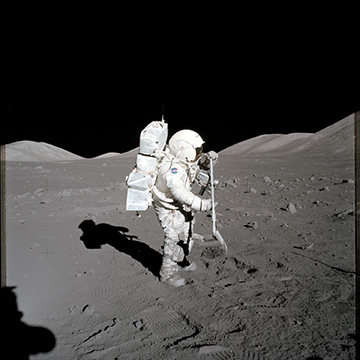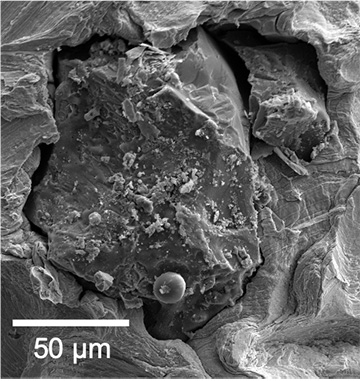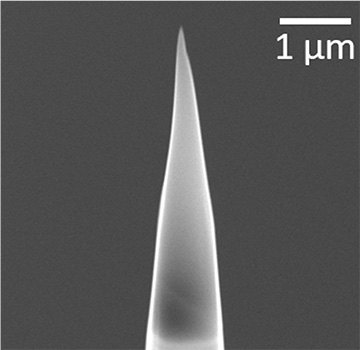
Apollo 17 astronaut and geologist Harrison Schmitt in 1972, collecting samples of lunar soil. [Image: NASA]
The several hundred kilograms of moon rocks returned by the Apollo missions of the late 1960s and early 1970s constitute a precious scientific resource. And, while they’ve been extensively studied since finding their way to Earth, much remains to be learned from them. But the lunar material available to earthly labs is inherently limited, and new samples lie on outcrops a quarter of a million miles away—a difficult hike for even the most intrepid field geologist.
That means that, in the continuing study of moon rocks already on Earth, it’s vital to apply techniques that preserve as much of the sample as possible for future generations of scientists. Now, a team led by geoscientists at the University of Chicago and the Field Museum of Chicago, USA, has demonstrated a laser-driven technique that can extract a wealth of new information, atom by atom, from a single grain of moon dust (Metorit. Planet. Sci., doi: 10.1111/maps.13443).
Investigating “space weathering”
The specific problem studied by the Chicago team, led by meteoritics professor Philipp Heck and first author and Ph.D. student Jennika Greer, involves “space weathering,” the alteration of minerals that takes place as the moon and other airless planets encounter the solar wind, micrometeoroids, cosmic rays and other extraterrestrial insults. These features of the harsh space environment leave a crusty patina a few tens of nanometers thick on a moon rock’s surface whose mineralogy can differ profoundly from that of the rest of the rock.
The impact of space weathering means, among other things, that the optical properties of the lunar surface don’t necessarily provide a direct clue to the rocks that lie only microns beneath the soil. Sussing out the difference between weathered and unweathered layers, the researchers believe, could enable a better understanding of the true composition not only of the moon, but of other planetary bodies far too distant for the collection of physical samples.
Nanocarpentry and laser ablation

The Chicago-led team used laser ablation to study space weathering in a single, tiny grain of lunar soil, shown here in an SEM image. [Image: © Jennika Greer, Field Museum]
To get at those questions, Greer, Heck, and the rest of the team (which also included scientists at Northwestern University, USA, and ETH Zürich, Switzerland) drew on a technique called atom probe tomography (APT). The researchers began with a single space-weathered grain from lunar samples brought back in 1972 from the Apollo 17 mission. Next, they used a focused ion beam to carve out tiny, sharp tips, less than a micron in diameter, at the surface of the grain—a process that Heck refers to as “nanocarpentry.”
Once the nanotips were milled out of the grain surface, they were zapped with a 355-nm UV laser delivering 250,000 pulses per second, at a chilly 30 K ambient temperature. The laser pulses popped off individual atoms, one by one, and sent them careening toward a detector surface. From there, the instrument acted as a time-of-flight mass spectrometer, as atoms of heavier elements take longer to reach the detector than lighter ones. Mapping these time-of-flight data to the grain allowed both its local composition and its spatial compositional variation to be inferred in 3D—at a resolution near the scale of individual atoms.
History lesson

An example of a “nanotip” carved out of a single grain of moon dust. Atom-by-atom laser ablation of the tip allowed high-res analysis of compositional changes attributable to space weathering—with minimal use of precious lunar samples. [Image: © Jennika Greer, Field Museum]
Collecting between 5 and 16 million atoms’ worth of data for each of four nanotips, the Chicago-led team found that the laser-driven APT technique could usefully distinguish between space-weathering products and the pristine lunar mineral (ilmenite) beneath the weathered layers. What’s more, the researchers were able to tease out some of the detailed history of this single grain through compositional zoning as the laser bored deeper into the various layers, distinguishing areas affected by solar-wind irradiation from other forms of space-weathering alteration.
The results stacked up well against previous transmission electron microscope (TEM) studies of space-weathering products in bulk lunar samples. That’s an indication that the team’s grain-based approach can yield usable results while keeping the consumption of precious lunar samples very low.
In a press release accompanying the research, Greer further noted that the technique could promise great results not only for lunar samples from the Apollo missions, but for other precious material from space, such as the tiny samples of distant asteroids soon to be brought back to Earth by the robotic missions Hayabusa2 and OSIRIS-REx. APT is “great for comprehensively characterizing small volumes of precious samples,” she said. “It uses so little material, but provides so much information.”
